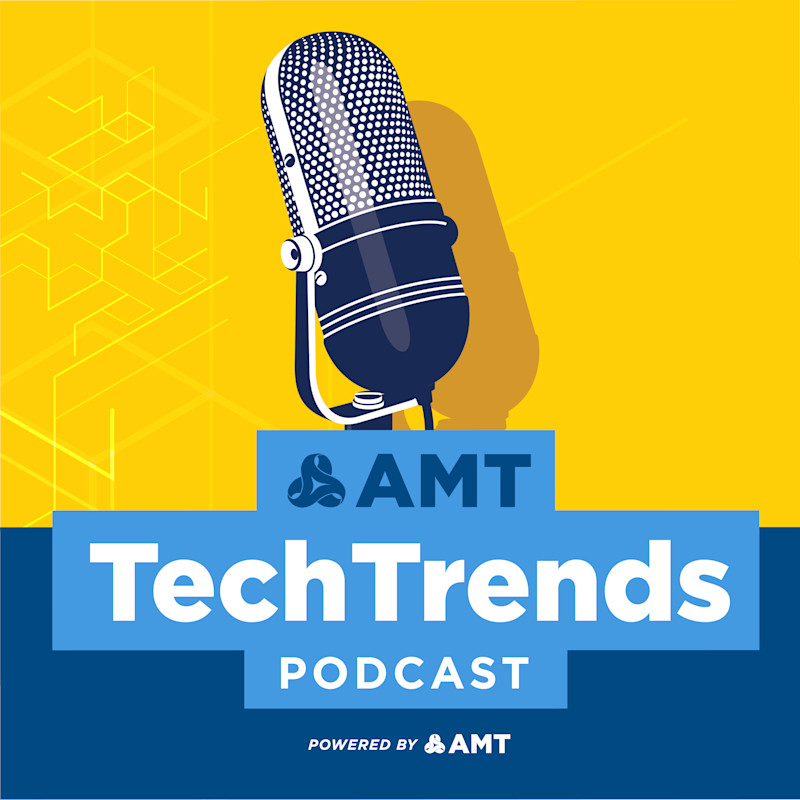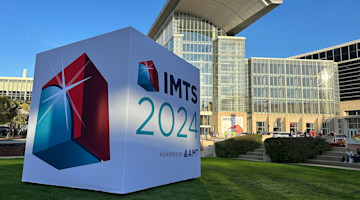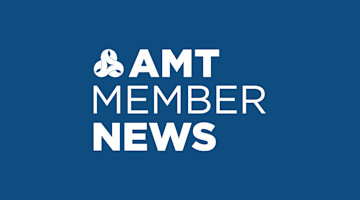Looking For More?
Watch this episode on YouTube
Connect with the Manufacturing Industry here www.amtonline.org/events
Discover the past, present, and future of American manufacturing with www.mmsonline.com/madeintheusapodcast
Explore, watch, read, learn, join, and connect at www.imts.com/
Tune in to the AM Radio podcast www.additivemanufacturing.media/zc/am-rad…o-podcast
For the latest in Manufacturing Technology news www.amtonline.org/home
Ramia Lloyd:
Welcome to the TechTrends podcast where we discuss the latest manufacturing technology, research and news. Today's episode is sponsored by AMT member Meetups. Hi guys. Did we say we're not doing names?
Benjamin Moses:
We'll skip right to it.
Ramia Lloyd:
Okay. I'm Ramia, in case you were wondering.
Benjamin Moses:
I want to talk about artificial intelligence, but the cost of AI. So I just signed up for Copilot, which is built on top of OpenAI because Microsoft has a big majority share of OpenAI and all that nonsense. But I've been testing a bunch of stuff. We use Grammarly and I was using OpenAI for a while. But I think a lot of people are underestimating that they have 10 subscriptions to 10 different AI things. Am I wrong on this?
Ramia Lloyd:
No.
Elissa:
No. So I don't have any AI subscriptions because I don't have a need for it at the moment. And also I'm terrified that I'm going to use it, and then... Because I'm in grad school right now, then I'm going to use it and-
Ramia Lloyd:
Fair.
Elissa:
... it's going to run through plagiarism software and they're going to be like, "What is this?" And I'm like, "No, I just use it to help." So I don't know how much it costs. I know my brother-in-law is obsessed with AI. He's giving me financial readiness presentations basically to help me with my finances, and I was like, "Oh, what are they going to be about?" He's like, "Oh, well, Microsoft Copilot's going to decide." And I'm like, "Oh my God."
Benjamin Moses:
Hey, thanks.
Elissa:
He's not really doing it if Copilot's doing it.
Ramia Lloyd:
No, exactly.
Benjamin Moses:
And it's funny that I did, I was setting up a poll with some of our committee members to figure out what day we want to do our next meeting. So I said, "Hey, Copilot, build me a forum and list the dates that are available, business days and have a multi-select." Just a forum. On those sell days, I was great. Shipped it out. I was like, "I'm not rushed." Got back, "Hey Ben, these dates are for 2023." I was like, "Oh, no. Copilot did me wrong. Why did you send me these dates?" Because I was talking to a couple of people here and we're talking about, they have Otterly, they have Paw, they have five different subscriptions going at the same time.
I'm like, "What's going on here? Why do you have so many different tools?" I feel like there's just this grab or you get an ad and they want to try it out, and I think there's a underlying business cost of all this experimentation where we haven't figured out. Sure, some of these AI tools are very specialized. I've been experimenting with generating art and things like that, and Microsoft Designer actually worked really, really well where I put in three words and I said, "Enhance this prompt," and it gave me a full paragraph and I was like, "These are the things that I want." So enhancing the prompts to get to the image I want, that was a very useful tool, which I feel like that pipeline of putting a couple of keywords and then it feeds on that and then it feeds that into an image. That was an interesting kind of feedback loop using AI.
Ramia Lloyd:
Yeah. Well-
Benjamin Moses:
But-
Ramia Lloyd:
Oh, go ahead.
Benjamin Moses:
No, I feel like a lot of people are signing up for 10 tools. Little do they know that each one is like $70 a month. You're almost paying a thousand dollars for five tools you're not using.
Ramia Lloyd:
So I Googled it and they say a total of AI, basically AI solution tools, all of them, will range from about $100 to $5,000 per month.
Elissa:
Oh, my gosh.
Benjamin Moses:
Yeah.
Ramia Lloyd:
That sounds about right. People are really shelling out. Also, I didn't realize OpenAI charges you by tokens.
Benjamin Moses:
Which the amount of calculations are trying to-
Elissa:
How BitCoin of them.
Ramia Lloyd:
Right. I'm like what? It says it charges 0.01 per 1000 tokens for input text and 0.03 cents per 1,000 tokens.
That's too much math. That's too much math.
Elissa:
For output text, what does that even mean?
Benjamin Moses:
Well, it's like the old economy for video games where you have to buy this credit and then you spend that credit. It's like, "Just charge me a flat fee."
Elissa:
Yeah. Well, and you had a good point about how it's killing the environment. It's data mining and data mining is killing our environment, and I think a lot of people kind of forget that the amount of energy that it takes for AI is absolutely absurd.
Benjamin Moses:
Just for a flamingo-wearing headphone.
Elissa:
Yeah, exactly.
It's insane.
Ramia Lloyd:
Just to compute how much you should walk in a day or something insane. It's 1,287 megawatts.
Benjamin Moses:
That's why Microsoft bought that nuclear power plant right down the street from us.
Elissa:
Crazy. Did you guys hear about the studio Ghibli?
Benjamin Moses:
Oh, man. That's a hot mess.
Ramia Lloyd:
Oh my God.
Benjamin Moses:
Can you recap that for me real quick?
Elissa:
I mean, from what I understand, I can recap it and basically there was this video that came out and it was advertising AI, I think, and it was all in Studio Ghibli's style, and there was a lot of people who came out and someone was like, "This was all created by AI. This is so cool." And someone said, "No, this was not created by AI. This is all work that has already been created that is just being basically plagiarized for this purpose." And so I think that when you think about something as big as Studio Ghibli, it's like, yeah, you're kind of messing up by just using such a well-known style.
Benjamin Moses:
It's interesting that they took that art style, which is very, very specific to that studio and that brand, which basically represents that brand. And the owner/creator of the brand said, "This is not what I want." He has no recourse to say, you've taken something from me, copied my brand, and I can't take that back. It's out in the world now. It's completely gone. He's lost it, and he was completely distraught. It's like, "This is not why we built all our films." All their films are very meticulously designed and drawn, and yet they've created these random images. This is not what I want. It's a very interesting dilemma.
Elissa:
I mean, it comes back to this whole when AI-generated images I think was becoming big even just a couple years ago, and all these artists were like AI is already taking away a lot of my business because if AI can generate the flamingo-wearing headphones, no one's going to pay me to make flamingo-wearing headphones. And so I've always had issues with AI. I will say I like when I Google something and the Google AI just summarizes what the findings are, although sometimes I'm like, "Okay, you definitely did not scrape that correctly because that cannot be right."
One time my sister Googled something and one of the cures or one of the treatments was to drink urine. She's like, "I don't think that's correct." Because it was not related at all, and so it was like, what website was that coming from?
Ramia Lloyd:
Somebody's Reddit. Somebody's deep dark Reddit post.
Elissa:
Yeah, but I mean the Studio Ghibli thing, that's the most, because I remember I literally saw it on I think Facebook and it, or I think it was Instagram and it was just like, yeah, it was this big thing where it was like, this is not created by AI. This was created by somebody else
And now they're just recreating memes that already exist in this different context. So now you're stealing the original person's meme identity and you're also creating and stealing the art style, and you're just creating something that one already exists and making something that no one asked for.
Benjamin Moses:
Nobody asked for it.
Ramia Lloyd:
Like please.
Elissa:
Because AI is something that doesn't need to exist. In an industrial capacity, I understand it. Using it to automate tasks and to help improve productivity and that kind of stuff, I get. I guess on the art side is where it really bothers me because I'm like, these are things that can all be created by an artist.
Benjamin Moses:
And I think that that does carry on for the industrial world where we look at the IP intellectual property, right? So it's starting to get into a gray area of if I use this tool, am I creating the IP? Do I own this or does this belong in the web? And there's a lot of court cases related to IP control that's using AI to create it.
Ramia Lloyd:
I love how Stephen's not here and we're like, "You know what sucks?" AI.
Elissa:
AI.
Ramia Lloyd:
No counterpoint.
Benjamin Moses:
People can talk about AI at our member Meetup. Can you tell us about today's sponsor?
Ramia Lloyd:
That was such a good segue.
Join us on May 7th in Charlotte for one of the many AMT member Meetups this year. The 2025 AMT member series in partnership with Women in Manufacturing and NTMA offers casual after hours networking events designed to connect professionals from the manufacturing technology sector. Meetups draw a diverse crowd of industry leaders, engineers, and decision makers from across the field. Go to amtonline.org/events for more.
Benjamin Moses:
Thanks, Rumia.
Ramia Lloyd:
Anytime, Ben.
Benjamin Moses:
Elissa.
Elissa:
Yeah.
Benjamin Moses:
Japan is building the world's first 3D printed train station. Is that true?
Elissa:
Yes.
Ramia Lloyd:
Of course they are.
Elissa:
This is an article on Vice, and what's funny is that it's actually already been built and it took less than three hours to build.
Ramia Lloyd:
Oh, shit.
Benjamin Moses:
Less than three hours?
Speaker 4:
Less than three hours. So it's located in Wakayama Prefecture. I'm not entirely sure exactly where that is.
Ramia Lloyd:
I don't even know how to spell it.
Elissa:
But it's in Japan, I can tell you that. And so it was built or printed in less than three hours, and it cost half as much as traditional concrete. Not only was it cost-effective, but it supposedly, it says supposedly in the article, earthquake-resistant too, which I've told you guys before I lived in Japan, earthquakes are a very regular occurrence. Everything is built to withstand earthquakes. So that's kind of an important feature of Japanese architecture.
Benjamin Moses:
I think the resurgence of 3D printing in construction, I mean, we saw homes, what, six years ago? Now we're starting to see, what's the word I'm looking for? Common grounds or more industrial applications. I mean, to be fair, train stations are kind of unique construction, especially in Japan, right? They're very open air or they have closed,
Elissa:
Beautiful.
Benjamin Moses:
Tops. So I'm kind of curious to see the next evolution of this they're going to go. Do they have a train that just prints along the rails that they go and it's like, "Every couple hours print a 3D station where I need it."
Ramia Lloyd:
Yeah.
Elissa:
I mean, if they did that, it'd be very efficient, I'm sure. It's supposed to officially open in July. It'll begin serving as a crucial gateway for travelers heading to the vacation destination of Jinoshima Island just in time for the summer. Oh, gosh. It just did the thing where the page reloaded. One second.
Ramia Lloyd:
I did find out that Wakayama is 60 miles south of Osaka.
Benjamin Moses:
Oh, that's a nice area.
Elissa:
Oh, okay.
Benjamin Moses:
Yeah, there's like a harbor down there.
Elissa:
Okay.
Ramia Lloyd:
Okay. So it's far down there, isn't it?
Yeah, it's pretty west.
Elissa:
I guess that makes sense because if they're going to an island and then they'll take the train. Okay, yeah, that makes sense. Let's see. So it says, according to Futurism, many of Japan's metro and regional train services are privately owned and act as property developers that rapidly develop urban areas around transportation hubs. Frankly, it's all a little shocking considering that as Futurism also points out, whenever our country privatizes its rail transportation, rail service usually gets significantly worse. That's not the case in Japan. If anyone has ever been to Japan, the rail system is, you can literally set your watch to it.
Benjamin Moses:
Except for the one time I'm there.
Elissa:
Except for the one time you were there.
Ramia Lloyd:
They knew.
Elissa:
Yes, that is true. I remember when you came back and told us that story. Not only was it on a train, it was on the bullet train.
Benjamin Moses:
The one train of all trains that's never late.
Ramia Lloyd:
And it was the first time in 30 something years that the bullet train has been late for anything.
Benjamin Moses:
It was catastrophic.
Elissa:
When you came back and told us that, I was like, that is like a once in a lifetime opportunity.
Ramia Lloyd:
They're probably still trying to figure out how that happened and fix it and make sure it never happens again.
Elissa:
But I mean, I think... They didn't really have any pictures of it in the article.
Benjamin Moses:
So you know what that means? We have to fly to Osaka to find this train station.
Elissa:
Let's do it.
Benjamin Moses:
We'll do a podcast over there.
Elissa:
So AMT will pay for it and it's research for the podcast. That'd be so cool if we could do an episode from the 3D printed train station.
Ramia Lloyd:
I actually did find, I don't know if it's a picture, but it's a mock-up of one on CNN Travel. I will figure out a way to clip it and insert it into this clip, but everyone look at how pretty it looks.
Elissa:
Oh, I do you like that.
Ramia Lloyd:
Looks really nice.
Elissa:
That's nice.
Benjamin Moses:
I think there's opportunities because you talk about the time to fab basically, and most of the industrial manufacturing sites I've been to are not much more than garages. Like metal-shelf garages. And I think there's a lot of opportunity between the utilities running all that within the facade and things like that to 3D print manufacturing facilities. So it's kind of interesting. I know the military's exploring printing, Ford operating bases and housing out there. I do think there's going to be an intersection in a couple of years to say print me an industrial park.
Elissa:
Yeah. Well, yeah, especially in somewhere like Japan.
Benjamin Moses:
Yeah.
Elissa:
Well, and it was brought to where the station is now. It was brought there in four pieces.
Benjamin Moses:
Oh, okay.
Elissa:
Think is what the article said.
Benjamin Moses:
Interesting.
Elissa:
So it was fabricated and then brought manufactured to the site.
Benjamin Moses:
So you don't have to print on site, which is an interesting dilemma.
Elissa:
Yeah.
Benjamin Moses:
Cool. I like that. I'm going to carry the conversation related to robots and 3D printing. So I found an article from MSN on how robots are helping teams like Hendrick Motorsports make better and faster race cars. I like this as a parallel to other industries because Motorsports is doing a lot on cutting edge manufacturing that they're seeing value in basically the race times.
Formula One has been pushing an envelope quite a bit on material science like composites, but also with additive. I ran across an article where they looked at heat exchanger. They reduced like 20% of the weight by going to an additive process, but that requires obviously some engineering to say what the parts should look like and then printing and all that stuff.
But I think this is kind of a parallel where they're looking at automating certain things where the volumes are fairly low. There's a single source of around 85% of the parts used to build NASCAR. It comes from a single supplier, so it's not like it's a real small volume. It's not like space volume, but it's probably closer to aerospace. Whereas you're building a couple of thousand part numbers throughout the year, maybe throughout the month, but very small lot numbers.
But they're looking at automating certain things and they talk about automating the metrology lab, automating things that are not seen as value to get them through that process as quickly as possible. So they launched some robot scanners and some other equipment to process the parts quickly through metrology. Also, simple stuff like using QR codes on the part themselves and using that to identify the parts throughout the entire process. So I thought it was a really interesting article on the evolution of Motorsports. NASCAR's fine. I don't watch it, but it is a decent volume production and the production that involves in NASCAR is very fascinating to me.
Ramia Lloyd:
I love this article because we are doing a thing with Hexagon and Hendrick Motorsports and I'm so excited to go and see all of this stuff, but I just think it's so cool that they're able to use robots and machining and to make things faster and easier, and I'm just excited to be there.
Elissa:
Is this related to the car that they brought to INTS? Was that with Hendrick Motorsports as well?
Benjamin Moses:
Hexagon brought in a different car. Hexagon brought in the Czinger 21 hypercar.
Elissa:
Okay.
Benjamin Moses:
They may have had the NASCAR on a different side, but the one they had in the metrology section was their hypercar, which is another cool scenario where you do small lots and I think that's a growing trend that we're seeing in automation is pushing. Well, instead of doing automation for automotive where you produce million and millions of parts of more flexible automation to produce 10 parts and then switch to the next part number, which is completely different shapes. So you switch all your tooling, switch all your end of factors, that type of scenario. It was fascinating. I really liked the article and I'm curious to see how this progresses into other sectors. Defense is growing really big where it's a really high mix of part numbers. Of course, aerospace and some other sectors are growing up quite a bit.
Ramia Lloyd:
In the article it says these 33 APSO arms and seven CMM's,
Elissa:
13 scanners, which is so crazy to me.
Benjamin Moses:
Yeah, the volume that they have is pretty high.
Elissa:
It's got to be a huge place.
Benjamin Moses:
Yep. We'll find out when we get there. So Ramia, where can they find more info about us?
Ramia Lloyd:
Techtrends.amtonline.org. Like, share, and subscribe. Bye guys.





